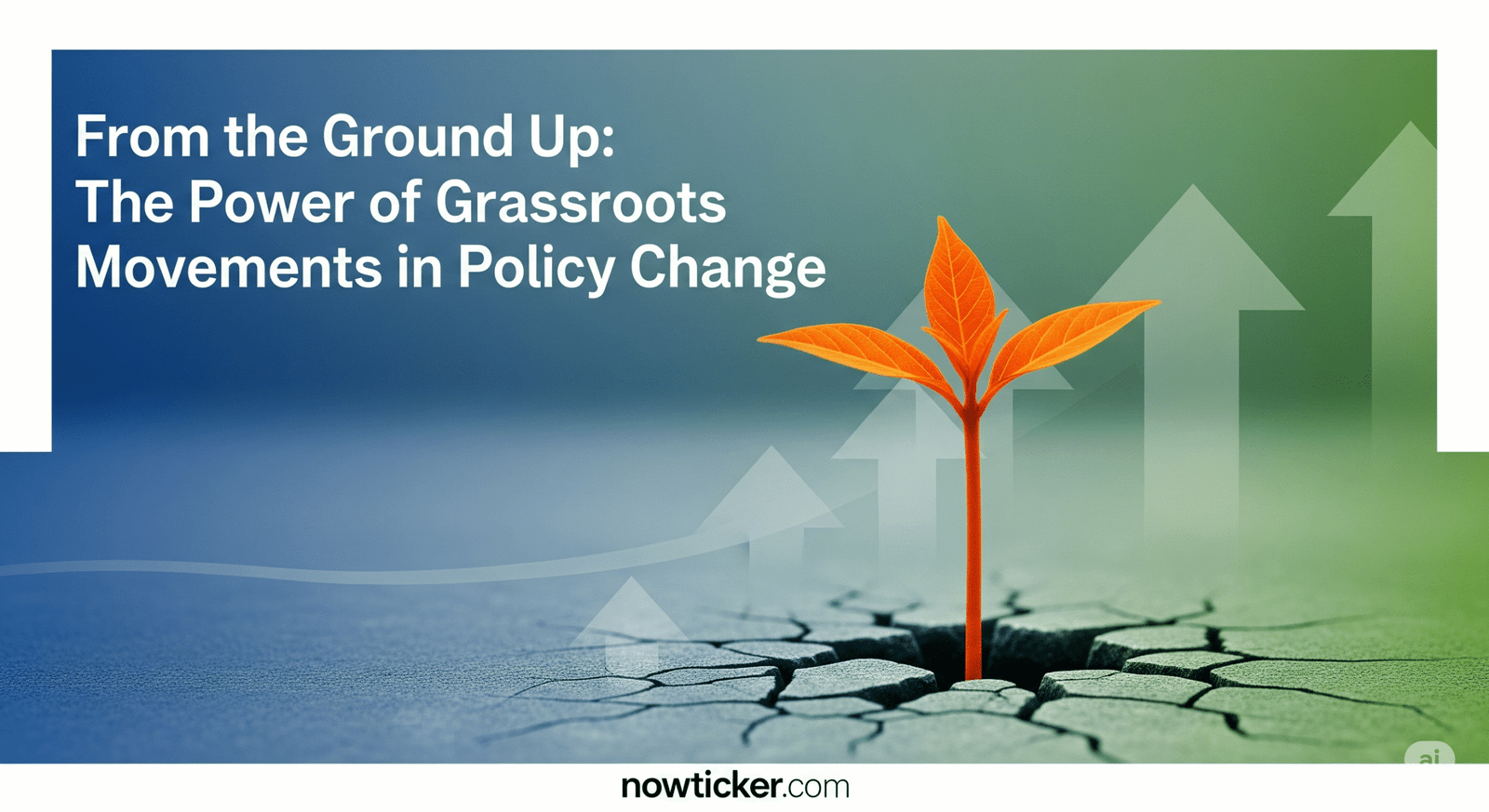Contents
Introduction
Grassroots movements, often characterized by community-driven initiatives, empower individuals to have a voice and influence policy. These movements have proven essential in addressing local and global issues, demonstrating how collective action can lead to impactful change. The landscape of policy-making is shifting, with grassroots organizing becoming a pivotal force in various sectors, from environmental protection to social justice. As traditional political avenues become increasingly polarized or inefficient, grassroots movements effectively mobilize communities, create awareness, and spark necessary reforms.
In an age where social media amplifies voices and connects disparate groups, grassroots movements can mobilize quickly and effectively. By emphasizing local involvement, these movements leverage shared experiences and narratives to craft policies that reflect the community’s needs. This article will explore key aspects of grassroots movements, share real-world examples, provide expert testimonials, and offer actionable tips on how to engage in effective grassroots activism.
The Role of Grassroots Movements in Shaping Policy
Historical Context
Grassroots movements have a rich history. From the abolition of slavery in the 19th century to the Civil Rights Movement in the 1960s, marginalized groups have often leveraged grassroots strategies to advocate for change when more traditional channels failed. Notably, the suffragette movement, which fought for women’s voting rights, sparked a worldwide dialogue around gender equality, becoming a foundational aspect of modern society’s political structure.
One powerful modern example is the Black Lives Matter (BLM) movement, which began in 2013 in response to the acquittal of George Zimmerman in the shooting of African American teen Trayvon Martin. Through grassroots organizing, BLM has galvanized millions and highlighted systemic racism and police brutality, influencing public policy and leading to discussions around police reform and racial justice initiatives nationwide.
Mechanisms of Change
Grassroots movements operate through various mechanisms to effect change, including community organizing, coalition-building, and advocacy campaigns. Filing petitions, organizing protests, and engaging in direct dialogues with policymakers are common strategies. In the digital age, online platforms (such as Change.org and social media networks) allow movements to reach broader audiences, facilitate fundraising, and foster community engagement.
As prominent activist and author Marshall Ganz states, “The power of grassroots movements lies in their ability to harness the stories of ordinary people.” These narratives not only resonate emotionally but also provide concrete illustrations of policy issues, making the need for change more tangible to decision-makers.
Case Studies of Successful Grassroots Movements
1. The Marriage Equality Movement
The journey toward legalizing same-sex marriage in several countries, including the United States, exemplifies how grassroots movements can reshape public policy. Activists engaged local communities and utilized social media to share stories, mobilizing support in unprecedented ways. Organizations like the Human Rights Campaign led campaigns that educated the public about LGBTQ+ rights while facilitating dialogues around acceptance.
Key milestones were achieved through grassroots organizing, culminating in the U.S. Supreme Court’s landmark decision in Obergefell v. Hodges in 2015. This case recognized the fundamental right to marry, emphasizing the power of grassroots efforts in shifting public consciousness and legal frameworks.
2. The Environmental Movement: Greenpeace
Since its inception in 1971, Greenpeace has transformed environmental activism through grassroots efforts. Initially beginning as a small group of activists, the organization grew by harnessing public sentiments around nuclear testing, whaling, and climate change. Through campaigns like “Save the Arctic,” Greenpeace mobilizes communities globally to advocate for policy changes that protect natural resources and promote sustainable practices.
A pivotal moment in their grassroots strategy was the 2019 Climate Strikes, where school students led demonstrations worldwide, demanding urgent action on climate change. This youth-led initiative exemplified how grassroots movements can draw global attention and galvanize policy advocacy that influences government actions.
Expert Reviews and Testimonials
Academic Perspectives
According to a study published in the journal Social Movement Studies, “Grassroots mobilization proves more effective in fostering civic engagement and influencing local policy compared to traditional lobbying” (Smith et al., 2025). Researchers emphasize that local grassroots efforts often inspire larger movements, making them critical components in the broader spectrum of advocacy.
Citizen Testimonials
Experts and community activists have shared their insights on the impact of grassroots movements. For instance, Claire Smith, an organizer from the environmental group 350.org, highlighted: “Grassroots movements empower ordinary people to challenge the status quo. Our campaigns have not only engaged communities but have also led to concrete changes in policy, such as renewable energy initiatives.”
Another example comes from Michael Chen, a participant in the BLM movement, who mentioned: “I joined because I felt unheard. Being part of this movement has allowed me to express my frustrations and advocate for change in my community.”
Trends in Grassroots Movements
The Rise of Digital Activism
The advent of technology and social media has dramatically altered how grassroots movements organize and communicate. Hashtags like #MeToo and #FridaysForFuture have emerged as rallying cries, providing platforms for voices that may have been previously marginalized.
These digital channels enable rapid mobilization, allowing activists to coordinate swiftly and disseminate information widely. Campaigns can garner support far beyond local communities, resulting in global movements for change.
Intersectionality in Activism
Modern grassroots movements increasingly recognize the importance of intersectionality, understanding that issues of race, gender, sexuality, and class are interconnected. This understanding has led to the formation of coalitions that unite diverse groups to advocate for comprehensive policy changes. For example, the Women’s March brought together various advocacy groups, emphasizing women’s rights while acknowledging issues of racial justice and environmentalism.
Practical Tips for Engaging in Grassroots Activism
1. Identify Local Issues
The first step in grassroots activism is identifying issues that resonate within your community. Attend town hall meetings, engage with local organizations, and listen to the voices of community members. Understand their concerns to build a relevant and impactful campaign.
2. Build a Coalition
Strengthening your movement involves inclusivity. Build coalitions by reaching out to local organizations with aligned values. Collaborative efforts often yield more significant results, as diverse perspectives can yield innovative solutions.
Personal narratives can be powerful motivators. Encourage community members to share their experiences related to the issues at hand. Collect these stories and use them in advocacy campaigns to humanize and contextualize policy issues.
4. Utilize Digital Tools
Harness the power of social media platforms to promote events, mobilize supporters, and engage in discussions. Create campaigns that utilize popular hashtags and encourage individuals to share content within their networks to amplify your message.
5. Engage with Policymakers
Establish relationships with local policymakers. Request meetings to discuss community concerns, armed with data and personal stories that highlight the need for change. When policymakers see their constituents advocating for specific issues, they are more likely to take action.
Frequently Asked Questions (FAQs)
1. What defines a grassroots movement?
A grassroots movement is characterized by its community-driven nature, often emerging from local concerns rather than top-down directives. These movements rely on the collective organizing of individuals to advocate for change.
2. How can I join or support a grassroots movement?
Start by researching local organizations working on issues you care about. Attend meetings, volunteer your time, and participate in campaigns. You can also support financially or by amplifying their messages through social media.
3. Are grassroots movements effective in enacting policy change?
Yes, grassroots movements have a proven track record of influencing policy. By mobilizing communities and creating public awareness, they can generate significant political pressure, leading to reforms and new legislation.
Social media amplifies messages, enabling rapid mobilization and engagement. It allows grassroots movements to reach wider audiences, share stories, and coordinate activities with unprecedented efficiency.
5. What challenges do grassroots movements face?
Grassroots movements often contend with resource limitations, public skepticism, and systemic obstacles in policy environments. Overcoming these challenges requires strategic planning and strong coalition-building efforts.
Conclusion
Grassroots movements embody the essence of collective action, proving that individuals can unite to challenge the status quo and advocate for meaningful policy change. Their success stories, from marriage equality to environmental advocacy, illustrate the power of community voices in shaping the landscape of public policy.
In the digital age, grassroots movements gain momentum through technology, connecting individuals across vast distances to create unified fronts for change. The rapid rise of these movements indicates that democracy can be redefined and revitalized through active engagement at local levels.
As we envision the future of activism, let us recognize the profound significance of grassroots organizing. The time is ripe for individuals to harness their collective voice to initiate policy discussions that matter. By implementing the strategies discussed, readers are empowered to take action, aligning their values and passions with transformative movements that could reshape the world.
This comprehensive examination highlights the vital role grassroots movements play in nurturing policy change, providing a deeper understanding of their mechanisms and impact. As we anticipate future developments in activism, the power of ordinary people uniting for a cause remains an enduring source of hope and motivation. Together, we can cultivate a more just and equitable society, starting from the ground up.



